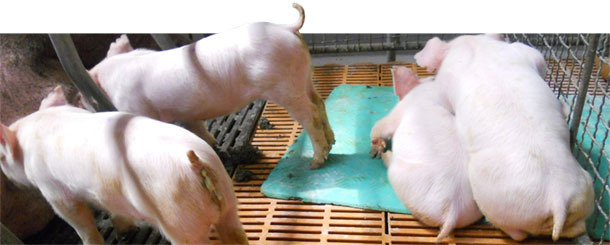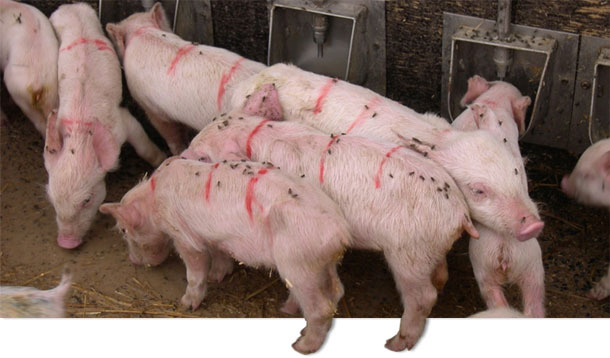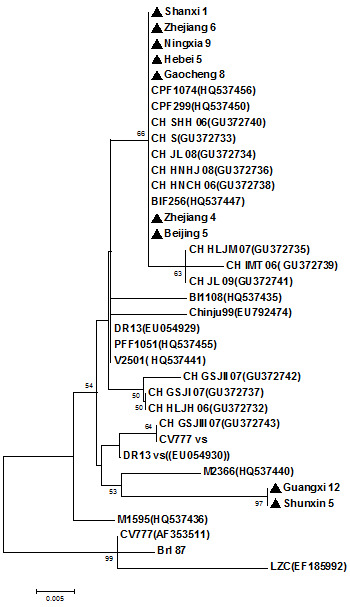Background
Porcine epidemic diarrhoea (PED) and transmissible gastroenteritis (TGE) are infectious diseases of pigs caused by similar, but antigenically distinct coronaviruses. They cause anorexia, vomiting and diarrhea in all ages of pigs, with higher mortality evident in baby piglets and younger weaned pigs.

There have been considerable changes in the prevalence of these diseases in Europe, Asia and North America in the past 40 years, with marked rises in the 1970’s and 1980’s followed by major reductions in occurrence in the 1990’s. The clear reduction in TGE prevalence in the 1990’s is attributed to the emergence of the natural vaccine potential of novel field strains of the porcine respiratory coronavirus. However, the ability of this respiratory virus to protect against PED in current outbreaks appears to be lacking.
Etiology and genomics
The PED virus is a single-standed positive-sense RNA coronavirus of 28 kb genome length. PED and PRRS virus are both ssRNA viruses, so both are often highly labile and readily mutate and recombine their genome to new strains. Coronavirus virions consist of a nucleocapsid core surrounded by an envelope containing three membrane proteins. PED also contains a membrane protein known as ORF 3.

Figure 1. Coronavirus morphology
Asian PED problems
Major PED outbreaks commenced in Korea in the 1990’s, followed by related PED outbreaks across east Asia. From 2005 to now, PED outbreaks due to these “Korean” strains have been a major feature of the pig farming industries of east Asia, particularly in the Philippines, which had several imports of Korean pigs in this period. A further recent rise in PED outbreaks across east Asia, since 2008, is attributed to new PED virus strains emerging in China, causing further disruptions to Asian pig production. These on-going PED outbreaks have been extensive across all regions of China, moving to Vietnam and Thailand. The pig industries in these countries have been consolidating and expanding, so there has been extensive movement of pigs and personnel across these countries, through this period.
A number of local attenuated and killed vaccines are available and have been used widely to combat both the original Korean strains and the newer Chinese strain outbreaks. PCR-based analysis of the ORF3 sequences of Asian PED strains has suggested that three groups of PED virus may be circulating, with some related to a commonly-used attenuated PED vaccine strain. The actual usefulness of these various Asian PED vaccines on problem farms has probably been very limited. Control of outbreaks on problem farms remains largely an attempt to raise herd immunity by use of live virus feedback material derived from affected piglet intestines. However, in strong contrast to the often fairly long-lasting benefit from this practice with previous outbreaks, the current outbreaks have shown only transient herd immunity with these programs. So farmers report recurring PED outbreaks happening every 6 months, each just as bad as the last attack. This novel disease pattern may be partly due to the further parallel activity of pathogenic PRRS strains across these industries at the same time, causing reduced herd and piglet immunity capability. In the past few months, numerous similar outbreaks of PED are also being reported across the USA.
Clinical signs and pathology
Typical clinical signs of current outbreaks of PED are anorexia, vomiting, dehydration and yellow watery diarrhoea in piglets (1 to 4 weeks-old). Challenge exposure studies indicate an incubation period of around 3 days. Typical Asian PED cases are illustrated in Figures 2 and 3.



Figure 2 and 3. Runt piglets, vomiting, wasting and diarrhoea typical of PED in current outbreaks in Asia.
Pathological examination of affected piglets shows yellow watery intestinal contents, thin intestinal mucosal layers and mild mesenteric lymph node enlargement. Histological examinations showed villous atrophy and stunting in sections from affected intestines.
|
Figure 4. Phylogenetic tree of ORF 3 gene from recent isolates of PED virus across Asia  |
Diagnostics for PED
At the laboratory, RNA can be extracted from suspensions of fresh intestinal material by commercial kits. Reverse transcription can provide cDNA for PCR reactions incorporating specific oligo-primers to the ORF3 gene or other sites.
Coronaviruses are usually difficult to cultivate and PED is no exception, with most efforts from field material only yielding virus cultures in a small minority of attempts. The usefulness of isolates is that the key genes can be fully sequenced, allowing strong comparisons to be made on virus pathogenicity and origins. For attempted culture, intestinal material from PCR-positive PED cases is homogenized, clarified and inoculated onto confluent cultures of Vero cells. PED virus-positive co-cultures are detected via CPE of cell fusion and syncytial formation in secondary passages. A typical phylogenetic tree for current Asian isolates of PED is shown in Figure 4.
The ORF 3 gene is considered a key element of PED pathogenesis, with its sequence being considered relatively stable. However, our recent phylogeny tree analyses (Figure 4) show that recent Chinese isolates appear to form two or more new groups, derived from southern or central-northern provinces. It is therefore possible that novel groups of PED virus have emerged in the field by point mutation and recombination events.
Conclusions
There is currently a high prevalence of PED virus among Chinese and other Asian pig farms,with PED virus detected in many serious diarrhoea outbreaks. PED infections are suggested to occur more commonly on larger farms. The PED-type disease from new strains in Asia and the USA is not readily distinguishable from that seen in previous field or previous challenge exposure studies. It is possible that the noted changes in the ORF 3 gene have enhanced the virulence of the PED virus, in terms of epidemiologic factors. The results of various studies suggest that recent Asian PED virus strains have only a limited genetic and protective relationship to the naturally-protective respiratory coronavirus. So the world continues to search for a useful PED vaccine.




